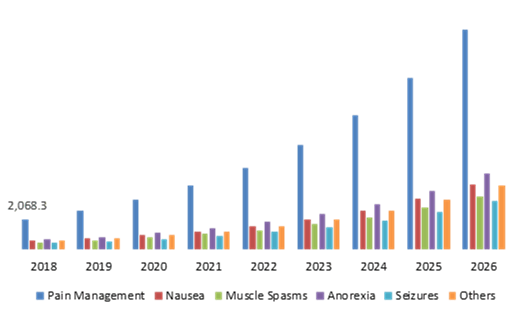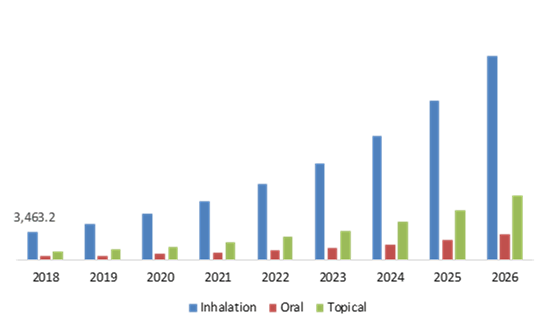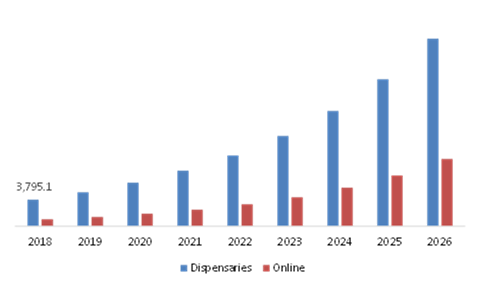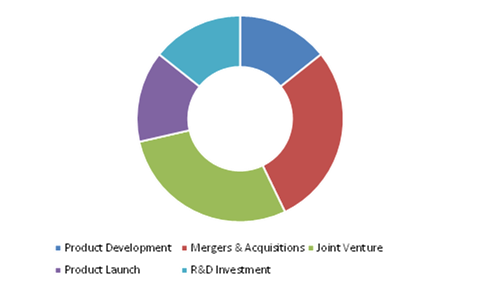Medical Marijuana Market Report
RA00059
Medical Marijuana Market, By Application (Pain Management, Muscle spasms, Nausea, Anorexia, Seizures, Others), By Route of Administration (Inhalation, Oral Topical), By Distribution Channel (Dispensaries, Online), Regional Analysis (North America, Europe, Asia Pacific, LAMEA) Global Opportunity Analysis and Industry Forecast, 2019–2026
Update Available On-Demand
Global Medical Marijuana Industry Insights 2026
The global Market forecast will be $33,211.7 Million by 2026, increasing from $4,810 Million in 2018 at a CAGR of 27.4%. Medical Marijuana market share for North America is anticipated to rise at a CAGR of 25.6% by generating a revenue of $10,627.8 by 2026. Asia-Pacific market size expected to generate a revenue of $7,373.0 Million by 2026.
Marijuana is plant that has a vital component called as cannabis which has multiple clinical properties to manufacture drugs that have therapeutic applications. Marijuana extracts are used to treat various diseases related to cancer, central nervous system, Alzheimer’s.
Medical Marijuana Market Drivers:
Rapid growth in the legalization of cannabis across the globe is coupled with growing demand for pain management is expected to boost the Global Medical Marijuana Market.
Research involving wide range of disciplines and development to offer efficient therapeutic intervention for diseases is anticipated to foster the medical marijuana market growth. Several extracts that are obtained from marijuana are found in clinical use. Thus, cannabis drug testing is also significant factor projected to spur the marijuana market in the near future. Extensive growth in number of economies approving the use of marijuana products for therapeutic application like HIV patients, pain management in cancer appetite stimulant, along with decreasing nausea is anticipated to impel the medical marijuana market. For instance, in 2019, thirty-three district and states of the Columbia have passed regulatory laws legalizing marijuana in some medical form.
Market Restraints:
Inadequate information about cannabis in the developing economies and lack of safety information will decline the medical marijuana market growth.
High growth in recreational, personal use and cultivation of marijuana, insufficient data and stringent government regulatory laws are anticipated to obstruct the global market throughout the projected period.
Market Opportunities:
Growing Agricultural crisis coupled with softening testing and sanctions for marijuana all over the globe is creating global opportunities for medical marijuana industry
The medical marijuana market is expanded enormously across the North America region. For example, in October 2018, in some part of the U.S. states along with Canada, the marijuana is liberalized and legalized for medicinal and as well as recreational uses. Moreover, any pharmaceutical companies operating in this sector are enhancing their research and development activities, in order to enhance the revenue. Therefore, these parameters will create enormous opportunities for the medical marijuana market to grow during the forecast period.
Medical Marijuana Market, by Application:
Pain Management segment will be most lucrative till 2026
Source: Research Dive Analysis
Pain management segment generated a revenue of $2,068.3 Million in 2018, and is projected to surpass $13,882.5 Million by 2026.
Based on application, the market is fragmented into pain management, anorexia, muscle spasms, seizures, nausea and others. The leading application segment is cancer pain, owing to growing global requirement of pain management. Moreover, cancer pain is the most difficult and perplexing patient problems encountered by therapist.
Medical Marijuana Market, by Route of Administration:
Inhalation segment will register revenue of $3,463.2 Million by 2026
Source: Research Dive Analysis
Inhalation segment registered a revenue of $3,463.2 Million in 2018, and is anticipated to cross $23,082.2 Million, during the forecasted period. Significantly due to, benefits of inhalation contain less noxious emissions and rapid effects. Moreover, rapidly growing asthma treatments are cured by cannabis through an inhaler. For instance, as per publication, of World Health Organization (WHO) around 1000 patients died every day due to Asthma.
Medical Marijuana Market, by Distribution Channel:
Online segment will register revenue of $8,767.9 Million by 2026 growing at healthy CAGR of 31.0%
Source: Research Dive Analysis
Dispensaries segment generated a revenue of $3,795.1 Million in 2018, and is projected to surpass $24,443.8 Million by 2026.
Reduction of penalties for cannabis users by several nation’s jurisdictions along with permission for supply of the drug, allowing key players to focus on various control models. Moreover, spectrum of marijuana legalization policies across the globe is a significant growth driver for dispensaries.
Online segment for medical marijuana market could be considered as significantly growing market across the globe. Swift changes in the legal status of cannabis attributed to growing demand from healthcare sector is anticipated to drive the market growth. Moreover, currently cannabis is legal and regulated in countries such as Canada and some regional part of U.S. is expected to drive the online segment for medical marijuana market.
Online segment generated revenue of $1,014.9 Million in 2018, and is further estimated to reach upto $8,767.9 Million, throughout the forecasted period.
Medical Marijuana Market system, by Region:
North America Medical Marijuana Market Overview 2026
Medical Marijuana market share for North America is anticipated to rise at a CAGR of 25.6% by generating a revenue of $10,627.8 by 2026.
North America has the prominent share in the medical marijuana market, throughout the projected period. This is significantly due to, legalization of marijuana on the federal level, by the House Judiciary Committee. In addition, marijuana programs in the perspective of good public health in US that have also escalated the global market growth. For instance, legalizing medical cannabis can significantly make positive impact on less opioid painkiller deaths.
Size of Medical Marijuana in Canada
The Canada marijuana market size will witness a significant growth, owing to the product legalization for medical research purposes, coupled with increasing investments for research & development activities by the operating companies in this region.
Asia-Pacific Medical Marijuana Market Outlook 2026:
Asia Pacific region will have lucrative opportunities for the market investors to grow over the coming years
Asia-Pacific Market size will generate a revenue of $7,373.0 Million by 2026. Currently, many Asian countries such as Bangkok, Seoul and Thailand are more emphasizing on normalization and legalization of medical cannabis with government license for the purpose of health-care applications. Moreover, South Korea also legalized medical marijuana is attributed in order to expand the treatment for chronic pain, epilepsy, and other diseases.
Key participants in global Medical Marijuana Market:
Merger & acquisition and advanced product development are the frequent strategies followed by the market players
Source: Research Dive Analysis
Some of the major medical marijuana market players include ABcann Medicinals, Inc., Aurora Cannabis, Inc., Aphria, Inc., Canopy Growth Corporation, Cannabis Sativa Inc., Emerald Health Therapeutics, Green Relief Inc., GW Pharmaceuticals, Insys Therapeutics, Inc., mCig to gain competitive advantage, these companies investing heavily in the R&D activities to develop cannabis based therapeutic drugs.
For instance, to fulfil the demand of the increasing patients, Green Relief Inc., a licensed producer of marijuana, has officially acquired a new facility unit in the Canada.
Report Scope:
| Aspect | Particulars |
| Historical Market Estimations | 2018-2019 |
| Base Year for Market Estimation | 2018 |
| Forecast timeline for Market Projection | 2019-2026 |
| Geographical Scope | North America, Europe, Asia-Pacific, LAMEA |
| Segmentation by Application |
|
| Segmentation by Route of Administration |
|
| Segmentation by Distribution Channel |
|
| Key Countries covered | U.S., Canada, Germany, France, Spain, Russia, Japan, China, India, South Korea, Australia, Brazil, and Saudi Arabia |
| Key Companies Profiled |
|
Q1. What is the size of Medical Marijuana Market system?
A. The global Medical Marijuana Market system size was over $4,810.0 Million in 2018, and is projected to reach $33,211.7 Million by 2026.
Q2. Who are the leading companies in the Medical Marijuana Market system?
A. Canopy Growth Corporation, Aphria, Inc. are some of the key players in the global Medical Marijuana Market system.
Q3. Which region possess greater investment opportunities in the coming future?
A. Asia-Pacific region possess great investment opportunities for the investors to witness the most promising growth in the coming years.
Q4. What is the growth rate of Asia-Pacific market?
A. Asia-Pacific Medical Marijuana Market system is anticipated to grow at 29.5% CAGR during the forecast period.
Q5. What are the strategies opted by the leading players in this market?
A. Technological advancements, product development, along with joint ventures are the key strategies opted by the operating companies in this market.
Q6. Which companies are investing more on R&D practices?
A. Aurora Cannabis, Inc., Aphria, Inc., Canopy Growth Corporation companies are investing more on R&D activities for developing new products and technologies.
1.Research Methodology
1.1.Desk Research
1.2.Real time insights and validation
1.3.Forecast model
1.4.Assumptions and forecast parameters
1.4.1.Assumptions
1.4.2.Forecast parameters
1.5.Data sources
1.5.1.Primary
1.5.2.Secondary
2.Executive Summary
2.1.360° summary
2.2.Application
2.3.Route of Administration
2.4.Distribution Channel
3.Market overview
3.1.Market segmentation & definitions
3.2.Key takeaways
3.2.1.Top investment pockets
3.2.2.Top winning strategies
3.3.Porter’s five forces analysis
3.3.1.Bargaining power of consumers
3.3.2.Bargaining power of suppliers
3.3.3.Threat of new entrants
3.3.4.Threat of substitutes
3.3.5.Competitive rivalry in the market
3.4.Market dynamics
3.4.1.Drivers
3.4.2.Restraints
3.4.3.Opportunities
3.5.Technology landscape
3.6.Regulatory landscape
3.7.Patent landscape
3.8.Market value chain analysis
3.8.1.Stress point analysis
3.9.Strategic overview
4.Medical Marijuana Market, by Application
4.1.Pain Management
4.1.1.Market size and forecast, by region, 2018-2026
4.1.2.Comparative market share analysis, 2018 & 2026
4.2.Muscle spasms
4.2.1.Market size and forecast, by region, 2018-2026
4.2.2.Comparative market share analysis, 2018 & 2026
4.3.Nausea
4.3.1.Market size and forecast, by region, 2018-2026
4.3.2.Comparative market share analysis, 2018 & 2026
4.4.Anorexia
4.4.1.Market size and forecast, by region, 2018-2026
4.4.2.Comparative market share analysis, 2018 & 2026
4.5.Seizures
4.5.1.Market size and forecast, by region, 2018-2026
4.5.2.Comparative market share analysis, 2018 & 2026
4.6.Others
4.6.1.Market size and forecast, by region, 2018-2026
4.6.2.Comparative market share analysis, 2018 & 2026
5.Medical Marijuana Market, by Route of Administration
5.1.Inhalation
5.1.1.Market size and forecast, by region, 2018-2026
5.1.2.Comparative market share analysis, 2018 & 2026
5.2.Oral
5.2.1.Market size and forecast, by region, 2018-2026
5.2.2.Comparative market share analysis, 2018 & 2026
5.3.Topical
5.3.1.Market size and forecast, by region, 2018-2026
5.3.2.Comparative market share analysis, 2018 & 2026
6.Medical Marijuana Market, by Distribution Channel
6.1.Dispensaries
6.1.1.Market size and forecast, by region, 2018-2026
6.1.2.Comparative market share analysis, 2018 & 2026
6.2.Online
6.2.1.Market size and forecast, by region, 2018-2026
6.2.2.Comparative market share analysis, 2018 & 2026
7.Medical Marijuana Market, by Region
7.1.North America
7.1.1.Market size and forecast, by application, 2018-2026
7.1.2.Market size and forecast, by route of administration, 2018-2026
7.1.3.Market size and forecast, by distribution channel, 2018-2026
7.1.4.Market size and forecast, by country, 2018-2026
7.1.5.Comparative market share analysis, 2018 & 2026
7.1.6.U.S.
7.1.6.1.Market size and forecast, by application, 2018-2026
7.1.6.2.Market size and forecast, by route of administration, 2018-2026
7.1.6.3.Market size and forecast, by distribution channel, 2018-2026
7.1.6.4.Comparative market share analysis, 2018 & 2026
7.1.7.Canada
7.1.7.1.Market size and forecast, by application, 2018-2026
7.1.7.2.Market size and forecast, by route of administration, 2018-2026
7.1.7.3.Market size and forecast, by distribution channel, 2018-2026
7.1.7.4.Comparative market share analysis, 2018 & 2026
7.1.8.Mexico
7.1.8.1.Market size and forecast, by application, 2018-2026
7.1.8.2.Market size and forecast, by route of administration, 2018-2026
7.1.8.3.Market size and forecast, by distribution channel, 2018-2026
7.1.8.4.Comparative market share analysis, 2018 & 2026
7.2.Europe
7.2.1.Market size and forecast, by application, 2018-2026
7.2.2.Market size and forecast, by route of administration, 2018-2026
7.2.3.Market size and forecast, by distribution channel, 2018-2026
7.2.4.Market size and forecast, by country, 2018-2026
7.2.5.Comparative market share analysis, 2018 & 2026
7.2.6.Germany
7.2.6.1.Market size and forecast, by application, 2018-2026
7.2.6.2.Market size and forecast, by route of administration, 2018-2026
7.2.6.3.Market size and forecast, by distribution channel, 2018-2026
7.2.6.4.Comparative market share analysis, 2018 & 2026
7.2.7.Spain
7.2.7.1.Market size and forecast, by application, 2018-2026
7.2.7.2.Market size and forecast, by route of administration, 2018-2026
7.2.7.3.Market size and forecast, by distribution channel, 2018-2026
7.2.7.4.Comparative market share analysis, 2018 & 2026
7.2.8.France
7.2.8.1.Market size and forecast, by application, 2018-2026
7.2.8.2.Market size and forecast, by route of administration, 2018-2026
7.2.8.3.Market size and forecast, by distribution channel, 2018-2026
7.2.8.4.Comparative market share analysis, 2018 & 2026
7.2.9.Italy
7.2.9.1.Market size and forecast, by application, 2018-2026
7.2.9.2.Market size and forecast, by route of administration, 2018-2026
7.2.9.3.Market size and forecast, by distribution channel, 2018-2026
7.2.9.4.Comparative market share analysis, 2018 & 2026
7.2.10.UK
7.2.10.1.Market size and forecast, by application, 2018-2026
7.2.10.2.Market size and forecast, by route of administration, 2018-2026
7.2.10.3.Market size and forecast, by distribution channel, 2018-2026
7.2.10.4.Comparative market share analysis, 2018 & 2026
7.2.11.Netherland
7.2.11.1.Market size and forecast, by application, 2018-2026
7.2.11.2.Market size and forecast, by route of administration, 2018-2026
7.2.11.3.Market size and forecast, by distribution channel, 2018-2026
7.2.11.4.Comparative market share analysis, 2018 & 2026
7.2.12.Ireland
7.2.12.1.Market size and forecast, by application, 2018-2026
7.2.12.2.Market size and forecast, by route of administration, 2018-2026
7.2.12.3.Market size and forecast, by distribution channel, 2018-2026
7.2.12.4.Comparative market share analysis, 2018 & 2026
7.2.13.Denmark
7.2.13.1.Market size and forecast, by application, 2018-2026
7.2.13.2.Market size and forecast, by route of administration, 2018-2026
7.2.13.3.Market size and forecast, by distribution channel, 2018-2026
7.2.13.4.Comparative market share analysis, 2018 & 2026
7.3.Asia-Pacific
7.3.1.Market size and forecast, by application, 2018-2026
7.3.2.Market size and forecast, by route of administration, 2018-2026
7.3.3.Market size and forecast, by distribution channel, 2018-2026
7.3.4.Market size and forecast, by country, 2018-2026
7.3.5.Comparative market share analysis, 2018 & 2026
7.3.6.Australia
7.3.6.1.Market size and forecast, by application, 2018-2026
7.3.6.2.Market size and forecast, by route of administration, 2018-2026
7.3.6.3.Market size and forecast, by distribution channel, 2018-2026
7.3.6.4.Comparative market share analysis, 2018 & 2026
7.3.7.Israel
7.3.7.1.Market size and forecast, by application, 2018-2026
7.3.7.2.Market size and forecast, by route of administration, 2018-2026
7.3.7.3.Market size and forecast, by distribution channel, 2018-2026
7.3.7.4.Comparative market share analysis, 2018 & 2026
7.3.8.China
7.3.8.1.Market size and forecast, by application, 2018-2026
7.3.8.2.Market size and forecast, by route of administration, 2018-2026
7.3.8.3.Market size and forecast, by distribution channel, 2018-2026
7.3.8.4.Comparative market share analysis, 2018 & 2026
7.4.LAMEA
7.4.1.Market size and forecast, by application, 2018-2026
7.4.2.Market size and forecast, by route of administration, 2018-2026
7.4.3.Market size and forecast, by distribution channel, 2018-2026
7.4.4.Market size and forecast, by country, 2018-2026
7.4.5.Comparative market share analysis, 2018 & 2026
7.4.6.Brazil
7.4.6.1.Market size and forecast, by application, 2018-2026
7.4.6.2.Market size and forecast, by route of administration, 2018-2026
7.4.6.3.Market size and forecast, by distribution channel, 2018-2026
7.4.6.4.Comparative market share analysis, 2018 & 2026
7.4.7.Argentina
7.4.7.1.Market size and forecast, by application, 2018-2026
7.4.7.2.Market size and forecast, by route of administration, 2018-2026
7.4.7.3.Market size and forecast, by distribution channel, 2018-2026
7.4.7.4.Comparative market share analysis, 2018 & 2026
7.4.8.Chile
7.4.8.1.Market size and forecast, by application, 2018-2026
7.4.8.2.Market size and forecast, by route of administration, 2018-2026
7.4.8.3.Market size and forecast, by distribution channel, 2018-2026
7.4.8.4.Comparative market share analysis, 2018 & 2026
7.4.9.Columbia
7.4.9.1.Market size and forecast, by application, 2018-2026
7.4.9.2.Market size and forecast, by route of administration, 2018-2026
7.4.9.3.Market size and forecast, by distribution channel, 2018-2026
7.4.9.4.Comparative market share analysis, 2018 & 2026
8.Company profiles
8.1.mCig
8.1.1.Business overview
8.1.2.Financial performance
8.1.3.Product portfolio
8.1.4.Recent strategic moves & developments
8.1.5.SWOT analysis
8.2.Cannabis Sativa Inc.
8.2.1.Business overview
8.2.2.Financial performance
8.2.3.Product portfolio
8.2.4.Recent strategic moves & developments
8.2.5.SWOT analysis
8.3.ABcann Medicinals,Inc.
8.3.1.Business overview
8.3.2.Financial performance
8.3.3.Product portfolio
8.3.4.Recent strategic moves & developments
8.3.5.SWOT analysis
8.4.Aurora Cannabis, Inc.
8.4.1.Business overview
8.4.2.Financial performance
8.4.3.Product portfolio
8.4.4.Recent strategic moves & developments
8.4.5.SWOT analysis
8.5.Emerald Health Therapeutics
8.5.1.Business overview
8.5.2.Financial performance
8.5.3.Product portfolio
8.5.4.Recent strategic moves & developments
8.5.5.SWOT analysis
8.6.Insys Therapeutics, Inc.
8.6.1.Business overview
8.6.2.Financial performance
8.6.3.Product portfolio
8.6.4.Recent strategic moves & developments
8.6.5.SWOT analysis
8.7.Aphria, Inc.
8.7.1.Business overview
8.7.2.Financial performance
8.7.3.Product portfolio
8.7.4.Recent strategic moves & developments
8.7.5.SWOT analysis
8.8.Canopy Growth Corporation
8.8.1.Business overview
8.8.2.Financial performance
8.8.3.Product portfolio
8.8.4.Recent strategic moves & developments
8.8.5.SWOT analysis
8.9.GW Pharmaceuticals
8.9.1.Business overview
8.9.2.Financial performance
8.9.3.Product portfolio
8.9.4.Recent strategic moves & developments
8.9.5.SWOT analysis
8.10.Green Relief Inc.
8.10.1.Business overview
8.10.2.Financial performance
8.10.3.Product portfolio
8.10.4.Recent strategic moves & developments
8.10.5.SWOT analysis
In the healthcare industry, medical marijuana is still in its introduction phase. The medicines manufactured in China are already produced by using cannabis, which is why this potent product is now gaining mass acceptance, globally. There are some cases that cannot be completely treated with the traditional medicines, and therefore, medical marijuana remains a large influence in the medical health industry.
Marijuana is plant that has a vital component called as cannabis which has multiple clinical properties to manufacture drugs that have therapeutic applications. Medical marijuana is used to treat various diseases related to Alzheimer’s, central nervous system, and cancer. The two types of marijuana plants are sativa and indica. Thus, to manufacture medicines, the manufactures use either of these two types, with several properties when exposed to the human body. The two forms in which medical marijuana is mostly found are dried and extract.
Recent Developments
According to the Nation Health Service (NHS), medical marijuana, also known as medicinal cannabis, is an extensive term used to relieve symptoms for any sort of cannabis-based medicine. A cannabis plant contains cannabinoids, which consists of not less than hundred different chemical compounds. The most well-known cannabinoids are cannabidiol (CBD) and tetrahydrocannabinol (THC).
All over the globe, the cannabis is already used for medicinal purposes in several countries. Or instance, in the Netherlands, cannabis can be available only if prescribed by the doctors for medicinal purposes. The House of Commons Health and Social Care Committee in December 2018, launched an inquiry into issues around medicinal cannabis. Later in September 2019, the government responded to the sanctions set out in committee’s December report. The NICE guidelines for prescribing the cannabis-based products were published in November 2019. The guidance mentions precise cannabis-based products used in the treatment of vomiting and intractable nausea, but not for the pain treatment.
Aurora Cannabis in August 2019, announced completion of acquisition with a company that provides low-cost hemp raw materials for extraction. The acquisition was made with a UK-based Hempco Food and Fiber Inc. to enable the company to strengthen its presence in the U.S. hemp-deprived CBD and hemp food markets.
Aphria in January 2019, completed its acquisition with a leading German-based company, CC Pharma. CC Pharma is involved in distribution of several pharmaceutical products across the European region and Germany. The wide distribution network of CC Pharma for medical marijuana will strengthen Aphria’s market presence and complement its revenue generation.
Future of Medical Marijuana Market
Global medical marijuana market is anticipated to spectate a progressive growth over the forecast period from 2019 to 2026. A number of countries in both developed and developing economies are approving the use of medical marijuana products for therapeutic application such as appetite stimulant, pain management in HIV/AIDS and cancer patients, and decreasing nausea, which is expected to drive the growth of global medical marijuana market. However, stringent government regulatory, high growth in recreational, personal use and cultivation of marijuana are likely to hamper the growth of the global market.
As per the Research Dive statistics of research report, the global medical marijuana market is anticipated to rise at a CAGR of 28.7% during the forecast period. The top gaining players of the global market in order to gain competitive advantage, are heavily investing in the R&D activities to develop cannabis based therapeutic drugs. Geographically, the North America medical marijuana industry will witness a significant growth owing to the growing requirement of medical cannabis for treating various medical conditions. Besides, awareness programs conducted by private as well as public associations and growing number of states legalizing medical use of cannabis will drive business growth in this region. Since 2014, for example, 13 states in the U.S. legalized the medical use of cannabis.
Personalize this research
- Triangulate with your own data
- Request your format and definition
- Get a deeper dive on a specific application, geography, customer or competitor
- + 1-888-961-4454 Toll - Free
- support@researchdive.com





